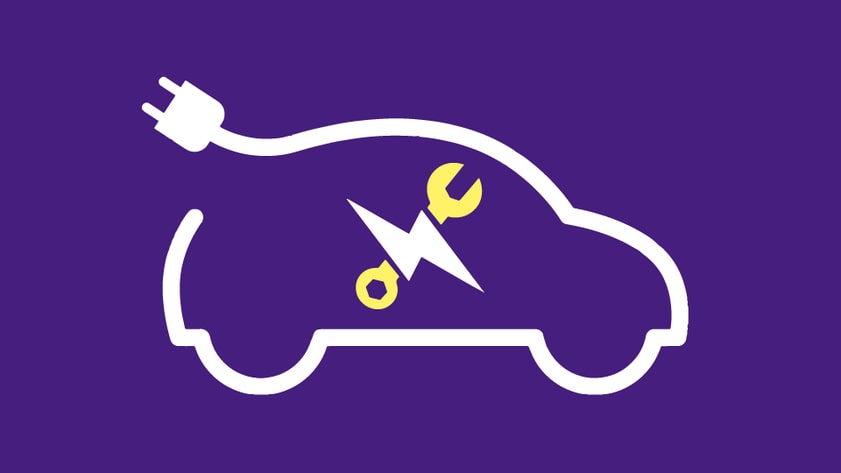Electric Car Maintenance Cost

If you’re considering buying an electric vehicle (EV) but worried about the cost of maintaining it, we have good news for you. A study by Consumer Reports shows that total cost of ownership (TCO) for an EV runs less than a gas-powered car even though the EV’s sticker price will often be higher. Consumer Reports looked at various factors involved in TCO, including purchase price and fueling and EV maintenance costs.
Over the life of the vehicle, maintenance and repair costs for EVs run significantly lower—in fact, they’re about half that of a gas powered car. Consumer Reports estimates buyers will save an average of $4,600. And the overall situation should get increasingly better as EV technology improves and EV battery cost declines. You’ll still need to follow a maintenance schedule to inspect critical parts and replace fluids, but your primary focus will be the electric vehicle battery, brakes, and tires.
Fewer Parts Mean Fewer Problems
The internal combustion engine (ICE) on a gas powered car requires scores of parts you won’t find on an EV. For example, you can say goodbye to the fuel injector and fuel pump, the exhaust system, catalytic converter, and muffler you have with gasoline vehicles. You won’t be replacing spark plugs, servicing the transmission, or paying for a tune-up, oil change, or coolant flushing. You will, however, still need to perform routine maintenance tasks—in other words, you’ll rotate the tires, top off the windshield fluid, and replace lights and hoses. The owner’s manual will give you a schedule to follow, which you need to do to ensure you keep the vehicle’s warranty in effect.
For example, we’ve provided the schedule below for the first five years or 60,000 miles for a Nissan Leaf in Schedule 1 service, which is more severe. Nissan defines severe as frequent short trips shorter than 5 miles in normal weather or 10 miles when it drops below freezing—or stop-and-go in hot weather, low-speed driving for long distances, in dry, dusty, or muddy conditions, or with a car-top carrier. In other words, severe service applies to just about everyone who doesn’t always drive on highways in 70°F weather.
Nissan Leaf Maintenance Schedule
.
7500 miles or 6 months
• Rotate tires
• Inspect the following:
Axle & suspension parts
Brake pads & rotors
Drive shaft boots
Front suspension ball joints
Steering gear and linkage
Steering linkage ball joints
.
15,000 miles or 12 months
Same as 7500 miles or 6 months, plus:
• Replace brake fluid
• Replace in-cabin microfilter
• Inspect the following:
Brake lines & cables
EV charging port
Reduction gear oil
.
22,500 miles or 18 months
Same as 7500 miles or 6 months, plus:
• Inspect Nissan Intelligent Key™ battery
.
30,000 miles or 18 months
Same as 15,000 miles or 12 months, plus:
• Inspect EV charging port sealing cap
.
37,500 miles or 30 months
Same as 7500 miles or 6 months
.
45,000 miles or 36 months
Same as 15,000 miles or 12 months
.
52,500 miles or 42 months
Same as 7500 miles or 6 months
.
60,000 miles or 48 months
Same as 30,000 miles or 18 months
Baby the Battery
One critical component of every EV is the battery—it’s massive, essential, and expensive if you mess it up. So, you need to treat your battery with the tender care it deserves to keep it humming along for years. It’s fairly simple:
• Keep the charge level between 20% and 80% when possible.
• Don’t charge the battery unless you’ll need the miles. It will degrade more quickly if you top it off after every short trip.
• Don’t let the battery sit for long periods either fully charged or uncharged.
• Don’t regularly use Level 3 public quick charging and risk overheating the battery.
• Don’t let your EV bake in the sun or freeze in the cold. The first can degrade the battery, the second can reduce the range.
Spare the Brakes
EVs feature two kinds of braking—regenerative braking and friction braking. With regenerative braking, the EV uses motor resistance to slow the car and sends the extra energy back to the battery. That shift happens every time you lift your foot off the accelerator or hit the brake pedal. Most EVs include the friction brakes you’ve used for years, but they tend to last longer than on gas-powered vehicles. Why? Because the regen system kicks in to help when the driver hits the brake pedal. According to CarFax, it’s not unusual for an electric car to go 100,000 miles before needing brake service.
Take It Easy on the Tires
The fat battery pack means EVs tend to weigh more than vehicles powered by ICEs. They also provide instant torque, giving you fast acceleration and more power than an ICE vehicle. Drivers who test their EV every time they’re behind the wheel may indeed need to replace the tires more often. Of course, it’s also possible to take a gentler approach. Either way, when replacing tires, consider those designed for electric vehicles. These tires generally feature robust materials and stronger construction, enhanced grip, and minimal rolling resistance for a smoother, quieter ride.
Treat your EV right and you’ll have it around for many years. To learn more about just how long that might be, What Is the Lifespan of an Electric Car?


